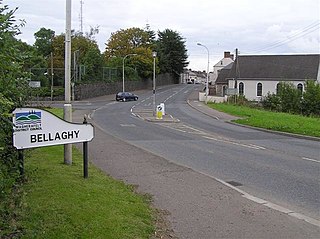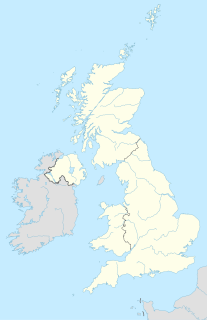Portglenone Parish Church is the Church of Ireland parish church of Portglenone, County Antrim, Northern Ireland.

Portglenone Parish Church is the Church of Ireland parish church of Portglenone, County Antrim, Northern Ireland.

Portglenone Church was consecrated in 1735, making it one of the oldest churches in the area. The porch was added and dedicated on 13 February 1912. The church was re-roofed in 1929.

| This article about a church or other Christian place of worship in the United Kingdom is a stub. You can help Wikipedia by expanding it. |
Francis Hutchinson was a British minister in Bury St Edmunds when he wrote a famous book debunking witchcraft prosecutions and subsequently was made Bishop of Down and Connor in Ireland.

Portglenone is a village and civil parish in County Antrim, Northern Ireland. It lies 8.5 miles (14 km) west of Ballymena. It had a population of 1,174 people in the 2011 Census. Portglenone is beside the smaller village of Glenone, from which it is separated by the River Bann.

Bellaghy is a village in County Londonderry, Northern Ireland. It lies north west of Lough Neagh and about 5 miles north east of Magherafelt. In the centre of the village three main roads lead to Magherafelt, Portglenone and Toome. It had a population of 1,063 people in the 2001 Census and is within Mid-Ulster District.

The Roman Catholic Diocese of Down and Connor, is a Roman Catholic diocese in Northern Ireland. It is one of eight suffragan dioceses in the ecclesiastical province of Armagh, subject to the Roman Catholic Archdiocese of Armagh. The incumbent is Bishop Noel Treanor.

Our Lady of Bethlehem Abbey, a Cistercian monastery in Portglenone, County Antrim, Northern Ireland, was founded in 1948 by Mount Melleray Abbey in County Waterford. The monks bought Portglenone House, a country mansion built about the year 1810 by the Church of Ireland Bishop, Dr. Alexander who demolished the local castle. History records that Sir Roger Casement often stayed in the house in the early years of the 20th century.

Glenone is a small village and townland in County Londonderry, Northern Ireland. In the 2001 Census it had a population of 318. It is situated within Mid-Ulster district.
Máiréad McAtamney-Magill is a retired Irish sportsperson. She played camogie with her local club Portglenone and with the Antrim senior inter-county team from 1958 until 1983. McAtamney captained Antrim to the All-Ireland title in 1979.
Tomlagh is an early-modern Irish district in what is now southern County Londonderry, Northern Ireland. Along with the ancient districts of Clandonnell, Glenconkeyne, and Killetra, it comprised the former barony of Loughinsholin. Tomlagh is stated as forming a four-or-five-mile-wide district running from Portglenone to Lough Beg. The townland of Annaghmore, near Castledawson is mentioned in Bodley's map from 1609 as lying within Tomlagh.

The Mass rock of Portglenone is one of the various Mass rocks which stand throughout Ireland. The rock was used during the mid-seventeenth century in an isolated location for Catholic Mass. These difficult times were a period dominated by the Penal Laws and known as the Penal Times.
The 1973 All-Ireland Senior Club Camogie Championship for the leading clubs in the women's team field sport of camogie was won by Oranmore (Gal), who defeated St Paul’s (Kk) in the final, played at Nowlan Park.
The 1992 All-Ireland Senior Club Camogie Championship for the leading clubs in the women's team field sport of camogie was won by Glen Rovers, who defeated Rathnure from Wexford in the final, played at Glen Rovers.
The 1972 All-Ireland Senior Club Camogie Championship for the leading clubs in the women's team field sport of camogie was won for the second year in succession by Austin Stacks (Du), who defeated Portglenone (Ant) in the final, played at Croke Park.
The 1978 All-Ireland Senior Club Camogie Championship for the leading clubs in the women's team field sport of camogie was won by Ballyagran of Limerick, who defeated Buffers Alley from Wexford in the final, played at Monamolin. It was the last club final to be played with the second crossbar, the "points bar," as per the rules of the game as amended by Congress in 1929.
The 1974 All-Ireland Senior Club Camogie Championship for the leading clubs in the women's team field sport of camogie was won by St Paul’s from Kilkenny, who defeated Oranmore from Galway in the final, played at Ballinderrin.
The 1982 All-Ireland Senior Club Camogie Championship for the leading clubs in the women's team field sport of camogie was won by Buffers Alley from Wexford, who defeated Athenry from Galway in the final, played at Birr. It was the second in a record sequence of four in a row won by the club.
Drummaul is a townland and civil parish in County Antrim, Northern Ireland. It is situated in the historic barony of Toome Upper and contains the town of Randalstown.
Duneane is a civil parish in County Antrim, Northern Ireland. It is situated in the historic barony of Toome Upper and contains the town of Toome.
St John O'Neill represented Randalstown in the Irish House of Commons from 1771 to 1776. and was High Sheriff of Antrim in 1774. He was returned unopposed at a by-election for Randalstown occasioned by the death of his father Charles O'Neill of Shane's Castle. Randalstown was a pocket borough of his family and its other MP was his elder brother John O'Neill, later 1st Viscount O'Neill.